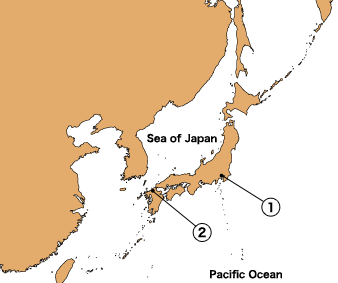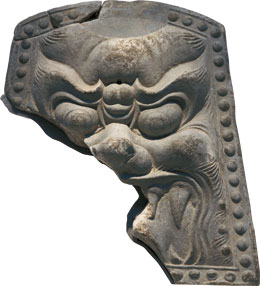Fukuoka in northwestern Kyushu has been Japan's gateway to the Korean peninsula and other parts of Asia since ancient times. Today, the city maintains modern links with continental Asia—there are regular international flights to and from Fukuoka Airport, and a ferry from Hakata Port runs between Fukuoka and Pusan in the Republic of Korea. Fukuoka is Kyushu's largest city (population, about 1.4 million).
Well over 2,000 years ago, techniques for the cultivation of rice and manufacture of iron and bronze ware were brought here from the Korean peninsula. From Kyushu they spread to other parts of the country, setting the stage for a flowering of Japanese culture. More than 1,000 years ago, the government headquarters for the entire island of Kyushu was established in Dazaifu near present-day Fukuoka, and many envoys set out from Nanotsu (now Fukuoka's Hakata Port) to Sui and T'ang China. The port city was Japan's most prosperous trading center from the 12th century to the mid-1500s. Near the end of the 13th century, Mongol armies and armadas set out twice to attack Japan through this area, and today you can still see fortifications constructed along the coast and inland, near Dazaifu, to defend the country from them.
Fukuoka is an obvious place to explore Japan's ancient ties to the Asian continent, so I went there for a visit.
The city faces Hakata Bay and is divided down the middle by the Naka River (see map). Fukuoka Castle was constructed west of the river in the early 1600s, and this part of the city, called Fukuoka, became the seat of the local feudal government. East of the river, the district called Hakata developed into a prosperous commercial center. Nakasu Island near the river mouth has long thrived as the city's entertainment district.
I begin my tour by walking from JR's Hakata Station to a group of temples in a quiet area nearby to the west. Shofuku-ji Temple is large, and its old earthen walls are most impressive. This was Japan's first Zen temple, founded by a priest named Eisai after he returned from his studies in Sung China. He brought back the seeds of tea plants, and it is thanks to him that tea cultivation spread throughout the country.
From the temple I walk toward the island of Nakasu. Before the bridge to the island, I come to a huge gingko tree marking the grounds of Kushida Shrine. The shrine is a favorite place among local residents, perhaps because the god responsible for bringing high profits to business is revered here. The shrine's awesome Hakata Gion Yamagasa summer festival is held from July 1 to 15 each year, with men wearing little more than loincloths carrying large yamagasa floats through the streets. The festival is supported by local merchants and attests to their energetic flair for business even today. During the festival, ornate kazari yamagasa figurines rise high into the air in many of the city's districts. I was lucky enough to see one displayed at the shrine when I was there.
I walk through the entertainment district on Nakasu Island—still too early for the evening crowd—then cross the bridge to Tenjin, the political and economic center of Kyushu. From there I continue on to the ruins of Fukuoka Castle. Today, about all you can see of the castle are the old stone walls, some moats, and a few buildings (mainly the gate and yagura turret). Maizuru Park occupies a wide area of the castle grounds and is open to the public. The guesthouse used by the Dazaifu government for foreign envoys from the 7th to the 11th centuries was excavated and reconstructed here. The ruins, called Korokan-ato, attest to Fukuoka's ancient contacts with the Asian continent.
The sun goes down and Nakasu's neon signs light up, reflected in the Naka River. This is the time for sidewalk stalls to open for hungry and thirsty customers. Fukuoka has developed into a modern city, but the old-fashioned yatai stalls on Nakasu Island and in the Tenjin district are still going strong, reminding one of Taipei, Hong Kong, Bangkok and other Asian cities.
The stalls offer ramen noodles in a soup, o-den ingredients simmered in a pot, tempura, fried gyoza dumplings and more. The benches at each stall seat no more than 10 at a time. There is something oddly welcoming in the way the people inside, all strangers to you, will open up a space for you on a bench. One stall in Tenjin, called Mami-chan, tempts me with the smell of delicious food, so I push through the split noren curtain and sit down. The stall owner suggests I start off with some gyoza and a chicken wing, and everything is very tasty. He stops working for a moment and grins at all of us: "So far, five couples who met for the first time under my roof have ended up getting married."
The next day I leave the hustle and bustle of Fukuoka, head for Dazaifu and get off at Nishitetsu Dazaifu Station. I walk along the boulevard leading to Dazaifu Temman Shrine, which is dedicated to the patron saint of learning, Sugawara Michizane. He was an excellent scholar himself, and a leading figure who pushed for political reform in the 9th century. He ran afoul of the authorities and was exiled to Dazaifu, where he died a broken man. Today, though, many students regard him as a supernatural agent who can help them pass their entrance exams.
Souvenir shops line both sides of the boulevard, and from inside come the sweet smell of specialty confectionaries and voices in the local dialect calling out, "Have one before you go!" The confectionaries are umegae-mochi, rice cakes with bean jam inside. They are hot and have a nice rustic flavor, and certainly hit the spot for any tired traveler.
Once inside the shrine grounds I take an escalator up a hill and come immediately to a huge modern building. The curved blue roof flows gently like an ocean wave over glass walls that reflect the green of the nearby highlands. I am at the Kyushu National Museum, and once inside I am struck by the huge atrium that leads the eye right up to the 4th floor.
This is Japan's fourth national museum (it opened in October 2005). Its aim is to show how Japan's unique cultural heritage developed through interaction with cultures in other parts of Asia—certainly a suitable theme for a place where exchange with continental Asia began in prehistoric times.
Kubota Motoko works for the museum's PR department. "This place is more than just a museum with displays for public education. For instance, on the first floor we have seminar rooms for lectures and an auditorium for concerts. Our goal is to be open to all, to maintain an environment where everyone can participate."
The main exhibition hall on the fourth floor presents the history of Japan and the Asian continent from the Old Stone Age to near-modern times. The open 1,500 m² hall lets your interests take you where you want, rather than giving you a fixed course to follow.
Back on the first floor, another special feature of the museum is Ajippa Square, which offers a hands-on experience of the cultures and history of Asia and Europe through music, dance, toys and displays. For the many local visitors and tourists from other parts of Asia, an informative earphone guided tour is offered in Chinese, English and Korean, in addition to Japanese.
The Kyushu National Museum plays up Japan's links with the rest of Asia, and here at Ajippa Square you become part of that international exchange.![]()

